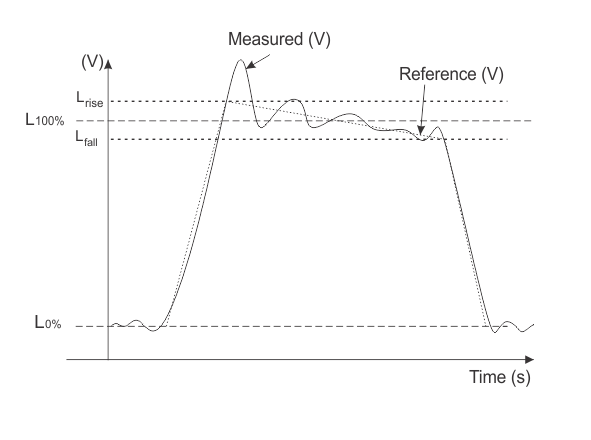Droop Metrics (Advanced-Radar/Hopping)
Menu Path:
This topic describes the Droop metrics displayed in the Pulse Table.
-
-
The reduction of pulse amplitude between the beginning of the pulse “On Time” to the end of the pulse “On Time.”
-
Droop is not calculated unless there are at least ten data points associated with the pulse on portion.
-
The measured Droop (dB) reports per pulse linear regression droop level change observed over the active pulse as a dB ratio, measured over pulse TOP time
-
Droop (dB) = Droop Start (dBm deciBels referenced to a milliWatt: dB relative to 1 milliwatt dissipated in the nominal input impedance of the analyzer) – Droop Stop (dBm) divided by the pulse TOP sample interval.
-
-
-
The ratio of Droop to the Amplitude (Range) and expressed as a percentage.
-
The measured Droop (%) reports per pulse linear regression droop level change observed over the active pulse as a percentage ratio, measured over pulse TOP time
-
Note the user selection of “Amplitude Units” parameter directly affects units of reported Droop (%), Overshoot (%) and Ripple (%) result metrics.
-
Droop (%), Overshoot (%) and Ripple (%) are reported in %Volt amplitude units when “Amplitude Unit” = “Volt”, otherwise they are reported in %Watt power units
-
When Amplitude Scaling is set to Real, the Droop (%) metric is reported in %V units.
-
When Amplitude Scaling is set to Magnitude, the Droop (%) metric is reported in %W units.
-
-
-
The rate at which the pulse top level decays, calculated as the difference between the power at the beginning of the pulse ON time and the power at the end of the pulse ON time, divided by the pulse amplitude.
-
The measured Droop Rate (dB/us) reports per pulse linear regression droop level change rate (or slope) observed over the active pulse, measured over pulse TOP time.
-
A positive Droop Rate (dB/us) result value indicates a reducing amplitude level over the pulse TOP sample interval (i.e. Droop Start (dBm) > Droop Stop (dBm)).
-
A negative Droop Rate (dB/us) result value indicates an increasing amplitude level over the pulse TOP sample interval (i.e. Droop Start (dBm) < Droop Stop (dBm))
-
-
-
The amplitude level where droop begins.
-
Droop Start (dBm) and Droop Stop (dBm) are the rising edge and falling edge 100% Top Levels respectively after accounting for pulse amplitude droop. They are derived from the start and stop levels of a best-fit linear regression line of each individual detected pulse's TOP amplitude samples measured in Volts.
-
-
-
The amplitude level where droop ends.
-
The Droop measurement interval is determined by the user-specified Droop analysis offset From Pulse Top Start and offset From Pulse Top End properties.

Amplitude Droop is calculated as the difference between the power at the beginning of the pulse ON time and the power at the end of the pulse ON time, divided by the pulse amplitude, as shown in the following formulas and illustration:




